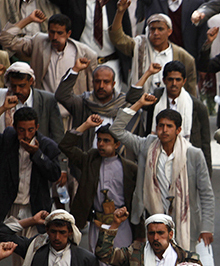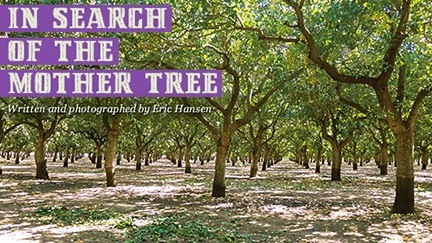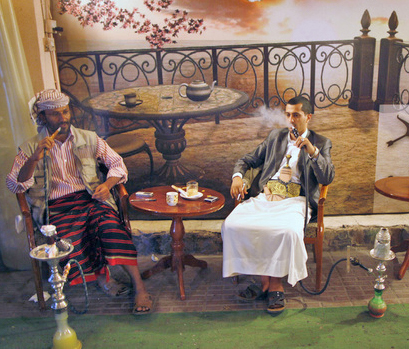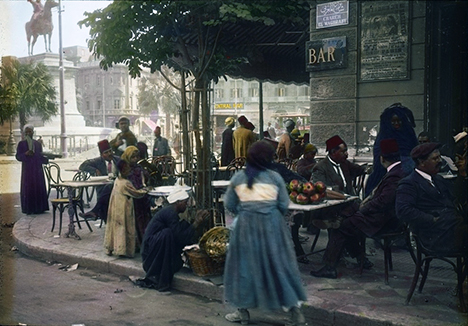
Here is a fascinating video on various types of dates and their use in the Hadramawt.

Here is a fascinating video on various types of dates and their use in the Hadramawt.

Only in Yemen would protesters come out in droves with cheeks bulging with qat. The image above is a close-up of a much larger photo published in AlMonitor and entitled “Supporters of the Shiite Houthi rebel group shout slogans during a demonstration in Sanaa against the deportation of Yemeni laborers from Saudi Arabia, April 5, 2013. (photo by REUTERS/Khaled Abdullah).”

Ibn Sina’s (d. 1037 CE) Qanun, copied in Shiraz in 1645 CE
For anyone interested in the history of Islamic medicine, there are some rare editions of texts by famous Muslim scholars like Ibn Sina (Avicenna), Ibn Masawayh, al-Antaki, al-Damiri, and others, including a few 19th century French translations published in North Africa. These are available to view or as pdfs at Yale University’s library. Below is the press release about the collection:
YALE UNIVERSITY PRESS RELEASE
This digitized collection of selected volumes of medical books and manuscripts, dating from 1300 to 1921, is drawn from the Medical Historical Library, Cushing/Whitney Medical Library. This collection reflects the Arabic and Persian intellectual efforts that translated, augmented, and transmitted Greek and Roman medical knowledge to Western societies during the Renaissance. It includes iconic works by authors such as Avicenna and al-Razi.
The Medical Historical Library, originally formed by the joining of three collections by bibliophiles Harvey Cushing, John Fulton, and Arnold Klebs, has over 120,000 volumes dating from the 12th to the 21st centuries. While primarily composed of works in Western medicine and science, a smaller selection of Arabic and Persian books and manuscripts are a “hidden collection” in the Library. Through the support of the Arcadia Fund, the Medical Historical Library was able to digitize Arabic and Persian books and manuscripts, as well as early translations in Latin, French, and English. Continue reading Islamic Medicine at Yale

Urban structure of Doha until the 1960s; Source: Scharfenort 2012 (Exhibition in Msheireb Enrichment Center)
The second issue of the new journal Arabian Humanities, with selections in both English and French, is now available online here.
The table of contents is reproduced below:
Juliette Honvault
Éditorial
Villes et dynamiques urbaines en péninsule Arabique
Cities and Urban Dynamics in the Arabian Peninsula
Claire Beaugrand, Amélie Le Renard et Roman Stadnicki
Au-delà de la Skyline : des villes en transformation dans la péninsule Arabique [Texte intégral]
Beyond the Skyline: Cities in Transformation in the Arabian Peninsula [Texte intégral | traduction]
Nelida Fuccaro
Preface: Urban Studies in the Arabian Peninsula: 6 Thoughts on the Field [Texte intégral]
Préface : Les études urbaines en péninsule Arabique
1. Croissances, politiques et projets
Growth paths, politics and projects
Brigitte Dumortier
Ras al‑Khaïmah, l’essor récent d’une ville moyenne du Golfe [Texte intégral]
Ras al‑Khaimah : the recent dynamics of a middle size city of the Arab‑Persian Gulf
Steffen Wippel
Développement et fragmentation d’une ville moyenne en cours de mondialisation : le cas de Salalah (Oman) [Texte intégral]
Development and Fragmentation of a Globalizing Secondary City: The Case of Salalah (Oman)
Sebastian Maisel
The Transformation of ‘Unayza: Where is the “Paris of Najd†today? [Texte intégral]
La transformation de ‘Unayza : où en est le « Paris du Najd » ?
Philippe Cadène
Koweït City : planification urbaine et stratégie régionale [Texte intégral]
Kuwait City: Urban Planning and Regional Strategy Continue reading Arabian Humanities Online

A feast for the eyes, ears, nose, throat…

In the current issue of ARAMCO World, which is available free online, there is an interesting article on how Iranian pistacios came to California. Click here for the full article. I attach a teaser below…
In 1957, a small experimental orchard in Chico, California distributed to commercial nut-growers a promising new variety of pistachio tree from Iran, called Kerman.
The United States Department of Agriculture wanted to see how these Kerman trees might perform in the richly fertile Central Valley of California.
By 2013, the Kerman had created a billion-dollar agricultural industry, and what was once a delicacy was a long way toward becoming a common household snack. University of California pistachio specialist Louise Ferguson calls the California Kerman pistachio tree “the single most successful plant introduction of the 20th century.â€

Men smoke shisha water pipes in a cafe in Sanaa, Oct. 1, 2011. (photo by REUTERS/Ahmed Jadallah)
Yemen’s Modern Coffee Shops: Progressive, Yet Exclusive
by Farea al-Muslimi, Al-Monitor, September 5 2013
SANAA, Yemen — Over the past few decades, Yemen has been known to conjure images of serious conservatism, isolation between men and women and male dominance over issues pertaining to daily life.
However, things look different here: A group of boys, girls, men and women are having discussions in modern coffee shops, which have become popular in the past 10 years and have significantly become more common across Sanaa in the past few years, including the historical part of the old city. The coffee shops, however, are more concentrated in the southwest of the city, where the richest and most open neighborhood, al-Siyasi Hadda, is located. They have become posh meeting spots for the privileged classes that can afford it.
There are coffee shops with foreign names that largely resemble any coffee shop in Amman, Cairo or Beirut, but the difference here is that the stone buildings are more elegant and posh.
Waitresses — hailing from Ethiopia and East Asia, alongside a few Yemenis — wear uniforms and serve you with a gentle smile that you cannot find elsewhere in the city. In fact, you usually cannot so much as look at a woman’s body, even if she were covered from head to toe. One can typically see little more than the standard black abaya, or a niqab for the more conservative.
You can order hot or cold beverages and Western snacks, the names of which are unknown to many people. Moreover, you can spot the most modern and cleanest coffee shops if you do not smoke shisha [sweetened tobacco smoked with a water pipe]. Some coffee shops offer it for high prices, while others do not find it suitable to be served in their establishment. Continue reading The Boon in Yemen’s Bun

The Qalawun Mosque in Cairo, built in the early 14th century
These color photographs of Cairo from 1910 are truly amazing and have been circulating the Internet. You can see them all here.

Beggars and locals at a sidewalk cafe in the Place De L’Opera in Cairo